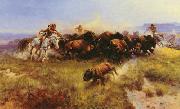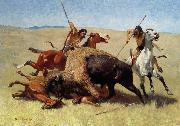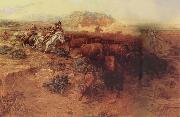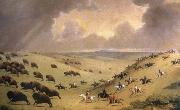Wholesale Oil Painting Reproductions No Minimum and Door to Door! |
|||||||||||
|
|
|||||||||||

|
|||||||||||
|
|
|
||||||||
All Charles M Russell Oil Paintings |
||||||||
|
|
||||||||
|
|
||||||||
|
Artist Introduction: American Painter, 1864-1926
American painter and sculptor. In 1880 he left his upper-class home in St Louis for Montana Territory. He worked briefly on a sheep ranch, spent two years as a hunter's and trapper's assistant and then became a cowboy. During his considerable spare daytime hours he painted, sketched and modelled small animal figures in clay (e.g. Antelope, 1915; Fort Worth, TX, Amon Carter Mus.). Although he painted a few exceptional oils and watercolours prior to 1900, the vast majority of his best work was done in the last two decades of his life. Typically the subject-matter centres around cowboy life (e.g. Wagon Boss, 1909; Tulsa, OK, Gilcrease Inst. Amer. Hist. & A.) and the Plains Indians, for whom he had great respect. The luminous Piegans (1918; Denver, CO, Mus. W. A.), with its depiction of the Plains Indians, is a reminder of the vastness of the American West. Russell's sense of humour and empathy for his subject-matter radiates from his paintings as pleasingly as do the clear colours of the high country. His bronze sculptures (e.g. Buffalo Hunt, 1905; Denver, CO, Mus. W. A.) depict the same dramatic and tension-packed themes as his paintings. |
||||||||
|
|
||||||||
|
The Buffalo Hunt Painting ID:: 4383 |
|
|||||||
Height Width |
INS/CM Quality |
|||||||
|
X |
| |||||||
|
|
||||||||
All Frederic Remington Oil Paintings |
||||||||
|
|
||||||||
|
|
||||||||
|
Artist Introduction: American Painter and Sculptor, 1861-1909
American painter, sculptor, illustrator and writer. In 1878 he began his studies at the newly formed School of the Fine Arts at Yale University in New Haven, CT, remaining there until 1880. This, along with a few months at the Art Students League in New York in 1886, was his only period of formal art training. In 1881 he roamed through the Dakotas, Montana, the Arizona Territory and Texas to document an era that was fast vanishing. He returned east and in 1882 had his first drawing published (25 Feb) in Harper's Weekly. Further commissions for illustrations followed, including that for Theodore Roosevelt's Ranch Life and the Hunting Trail (New York, 1888) (see BOOK ILLUSTRATION, fig. 8). |
||||||||
|
|
||||||||
|
The Buffalo Hunt Painting ID:: 41458 |
mk162
1890
oil on canvas
34x49
|
|||||||
Height Width |
INS/CM Quality |
|||||||
|
X |
| |||||||
|
|
||||||||
All Charles M Russell Oil Paintings |
||||||||
|
|
||||||||
|
|
||||||||
|
Artist Introduction: American Painter, 1864-1926
American painter and sculptor. In 1880 he left his upper-class home in St Louis for Montana Territory. He worked briefly on a sheep ranch, spent two years as a hunter's and trapper's assistant and then became a cowboy. During his considerable spare daytime hours he painted, sketched and modelled small animal figures in clay (e.g. Antelope, 1915; Fort Worth, TX, Amon Carter Mus.). Although he painted a few exceptional oils and watercolours prior to 1900, the vast majority of his best work was done in the last two decades of his life. Typically the subject-matter centres around cowboy life (e.g. Wagon Boss, 1909; Tulsa, OK, Gilcrease Inst. Amer. Hist. & A.) and the Plains Indians, for whom he had great respect. The luminous Piegans (1918; Denver, CO, Mus. W. A.), with its depiction of the Plains Indians, is a reminder of the vastness of the American West. Russell's sense of humour and empathy for his subject-matter radiates from his paintings as pleasingly as do the clear colours of the high country. His bronze sculptures (e.g. Buffalo Hunt, 1905; Denver, CO, Mus. W. A.) depict the same dramatic and tension-packed themes as his paintings. |
||||||||
|
|
||||||||
|
The Buffalo hunt Painting ID:: 50966 |
mk217
|
|||||||
Height Width |
INS/CM Quality |
|||||||
|
X |
| |||||||
|
|
||||||||
All Paul Klee Oil Paintings |
||||||||
|
|
||||||||
|
|
||||||||
|
Artist Introduction: German
1879-1940
Paul Klee Gallery
was a Swiss painter of German nationality. His highly individual style was influenced by many different art trends, including expressionism, cubism, and surrealism. He was a student of orientalism. Klee was a natural draftsman who experimented with and eventually mastered color theory, and wrote extensively about it. His works reflect his dry humor and his sometimes child-like perspective, his personal moods and beliefs, and his musicality. He and his friend, the Russian painter Wassily Kandinsky, were also famous for teaching at the Bauhaus school of art and architecture. |
||||||||
|
|
||||||||
|
the buffalo hunt Painting ID:: 56227 |
mk247
c.1850,oil on canvas,private collection |
|||||||
Height Width |
INS/CM Quality |
|||||||
|
X |
| |||||||
|
|
||||||||
|
Prev Next
|
||||||||
|
|
||||||||
|
Related Paintings to Paul Klee :. |
||||||||
|
|
||||||||
|
CONTACT US |




